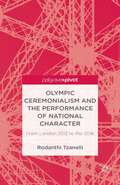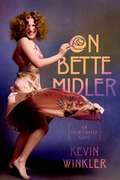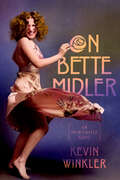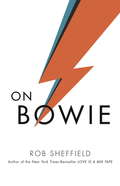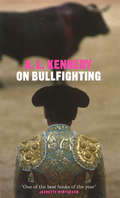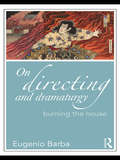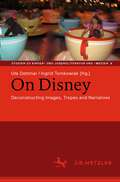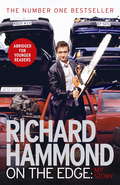- Table View
- List View
Olympic Ceremonialism and The Performance of National Character: From London 2012 to Rio 2016 (Palgrave Studies in the Olympic and Paralympic Games)
by R. TzanelliThis book examines the London 2012 opening and closing ceremonies and the handover to Rio 2016 as articulations of national and cosmopolitan belonging. The ceremonial performances supported imaginative travel and created a tornadóros: an ideal form of 'human' that manipulates audiovisual narratives of culture and identity for global audiences.
The Omen (Devil's Advocates)
by Adrian SchoberDirected by Richard Donner and written by David Seltzer, The Omen (1976) is perhaps the best in the devil-child cycle of movies that followed in the wake of Rosemary’s Baby and The Exorcist. Released to a highly suggestible public, The Omen became a major commercial success, in no small part due to an elaborate pre-sell campaign that played and preyed on apocalyptic fears and a renewed belief in the Devil and the supernatural. Since polarising critics and religious groups upon its release, The Omen has earned its place in the horror film canon. It’s a film that works on different levels, is imbued with nuance, ambiguity and subtext, and is open to opposing interpretations. Reflecting the film’s cultural impact and legacy, the name ‘Damien’ has since become a pop culture byword for an evil child. Adrian Schober’s Devil’s Advocate entry covers the genesis, authorship, production history, marketing and reception of The Omen, before going on to examine the overarching theme of paranoia that drives the narrative: paranoia about the 'end times'; paranoia about government and conspiracy; paranoia about child rearing (especially, if one strips away the layer of Satanism); and paranoia about imagined threats to the right-wing Establishment from liberal and post-countercultural forces of the 1970s.
Omnibus Films: Theorizing Transauthorial Cinema
by David Scott DiffrientOmnibus films bring together the contributions of two or more filmmakers. Does this make them inherently contradictory texts? How do they challenge critical categories in cinema studies? What are their implications for auteur theory? As the first book-length exploration of internationally distributed, multi-director episode films, David Scott Diffrient’s Omnibus Films: Theorizing Transauthorial Cinema fills a considerable gap in the history of world cinema and aims to expand contemporary understandings of authorship, genre, narrative, and transnational production and reception. Delving into such unique yet representative case studies as If I Had a Million (1932), Forever and a Day (1943), Dead of Night (1945), Quartet (1948), Love and the City (1953), Boccaccio ’70, (1962), New York Stories (1989), Tickets (2005), Visions of Europe (2005), and Paris, je t’aime (2006), this book covers much conceptual ground and crosses narrative as well as national borders in much the same way that omnibus films do. Omnibus Films is a particularly thought-provoking book for those working in the fields of auteur theory, film genre and transnational cinema, and is suitable for advanced students in Cinema Studies.
Omnibus Films: Theorizing Transauthorial Cinema (Edinburgh University Press)
by David Scott DiffrientOmnibus films bring together the contributions of two or more filmmakers. Does this make them inherently contradictory texts? How do they challenge critical categories in cinema studies? What are their implications for auteur theory? As the first book-length exploration of internationally distributed, multi-director episode films, David Scott Diffrient’s Omnibus Films: Theorizing Transauthorial Cinema fills a considerable gap in the history of world cinema and aims to expand contemporary understandings of authorship, genre, narrative, and transnational production and reception. Delving into such unique yet representative case studies as If I Had a Million (1932), Forever and a Day (1943), Dead of Night (1945), Quartet (1948), Love and the City (1953), Boccaccio ’70, (1962), New York Stories (1989), Tickets (2005), Visions of Europe (2005), and Paris, je t’aime (2006), this book covers much conceptual ground and crosses narrative as well as national borders in much the same way that omnibus films do. Omnibus Films is a particularly thought-provoking book for those working in the fields of auteur theory, film genre and transnational cinema, and is suitable for advanced students in Cinema Studies.
On Animation: The Director's Perspective Vol 1
by Ron DiamondBe a fly on the wall as industry leaders Bill Kroyer and Tom Sito take us through insightful face-to-face interviews, revealing, in these two volumes, the journeys of 23 world-class directors as they candidly share their experiences and personal views on the process of making feature animated films. The interviews were produced and edited by Ron Diamond. Your job is not to be the one with the answers. You should be the one that gets the answers. That’s your job. You need to make friends and get to know your crew. These folks are your talent, your bag of tricks. And that’s where you’re going to find answers to the big problems - Andrew Stanton It’s hard. Yet the pain you go through to get what you need for your film enriches you, and it enriches the film. – Brenda Chapman Frank and Ollie always used to say that great character animation contains movement that is generated by the character’s thought process. It can’t be plain movement. – John Lasseter The beauty of clay is that it doesn’t have to be too polished, or too smooth and sophisticated. You don’t want it to be mechanical and lifeless. – Nick Park The good thing about animation is that tape is very cheap. Let the actor try things. This is where animation gets to play with spontaneity. You want to capture that line as it has never been said before. And, most likely, if you asked the actor to do it again, he or she just can’t repeat that exact performance. But you got it. – Ron Clements
On Animation: The Director's Perspective Vol 2
by Ron DiamondOn Animation: The Director's Perspective is a collection of interviews with 23 animated feature-film directors. These extensive interviews were conducted over the past several years by filmmakers and educators (and peers to the directors interviews) Tom Sito and Bill Kroyer. Interviews cover in-depth discussion of each director's career -- focusing on their creative development, their films, lesson learned and advice. The interviews were edited and produced by Ron Diamond.Key FeaturesInterviews with the greatest living legends in animationOffers profound insight into the creative process of these giantsGrants advice and lessons for inspiring animators
On Animation: The Director's Perspective Vol 1
by Ron DiamondBe a fly on the wall as industry leaders Bill Kroyer and Tom Sito take us through insightful face-to-face interviews, revealing, in these two volumes, the journeys of 23 world-class directors as they candidly share their experiences and personal views on the process of making feature animated films. The interviews were produced and edited by Ron Diamond. Your job is not to be the one with the answers. You should be the one that gets the answers. That’s your job. You need to make friends and get to know your crew. These folks are your talent, your bag of tricks. And that’s where you’re going to find answers to the big problems - Andrew Stanton It’s hard. Yet the pain you go through to get what you need for your film enriches you, and it enriches the film. – Brenda Chapman Frank and Ollie always used to say that great character animation contains movement that is generated by the character’s thought process. It can’t be plain movement. – John Lasseter The beauty of clay is that it doesn’t have to be too polished, or too smooth and sophisticated. You don’t want it to be mechanical and lifeless. – Nick Park The good thing about animation is that tape is very cheap. Let the actor try things. This is where animation gets to play with spontaneity. You want to capture that line as it has never been said before. And, most likely, if you asked the actor to do it again, he or she just can’t repeat that exact performance. But you got it. – Ron Clements
On Animation: The Director's Perspective Vol 2
by Ron DiamondOn Animation: The Director's Perspective is a collection of interviews with 23 animated feature-film directors. These extensive interviews were conducted over the past several years by filmmakers and educators (and peers to the directors interviews) Tom Sito and Bill Kroyer. Interviews cover in-depth discussion of each director's career -- focusing on their creative development, their films, lesson learned and advice. The interviews were edited and produced by Ron Diamond.Key FeaturesInterviews with the greatest living legends in animationOffers profound insight into the creative process of these giantsGrants advice and lessons for inspiring animators
On Audrey Hepburn: An Opinionated Guide
by Steven CohanWhy should Audrey Hepburn matter today? This lively and engaging book revises the contemporary view of Hepburn that sees her primarily as a fashion icon and style guru, frozen in images from Breakfast at Tiffany's and My Fair Lady. Author Steven Cohan argues that her films, more than her biography or her likeness in stock images and magazine photos, are essential to understanding both her importance as one of the all-time major stars to emerge in Hollywood after World War II and her lasting fame in the 21st century. On Audrey Hepburn examines the key elements--her expressive face, her distinctive voice, her unorthodox body-that contributed to her persona and led to her charismatic presence onscreen. While pointing to the many contradictions inhering in her star image, Cohan emphasizes the liminality Hepburn represented, demonstrating how her characters' mischief, intelligence, and desiring supplied the primary motor for the Cinderella plots, resisted the films' patriarchal template and closures, and complicated her asymmetrical casting opposite older male stars. Similarly, Hepburn's close relation with designer Hubert de Givenchy, which established her identification with haute couture, enhanced her movement onscreen, offering a pathway through spectacle for viewer identification with her energy and agency. With Hepburn in Givenchy on screen, Cohan argues, fashion worked as a transformative event for her characters. On Audrey Hepburn further looks at how, playing a woman threatened with deception and murder in thrillers, Hepburn reversed the conventional role of women in this genre through her strong female characters who confront and deal with danger on their own terms. Finally, the book examines Hepburn's skill as actress, considering her expert timing, use of props, facial and vocal expressions, interaction with other actors in an ensemble, and the overall nuance with which she developed complex characterizations. On Audrey Hepburn is an entertaining and insightful guide to this star through her films, reminding readers why she was so immediately popular after her breakout roles in Roman Holiday and Sabrina, why she had such a crucial influence on women's fashions, and why she received so much acclaim and award recognition as an actress in the US and abroad.
On Audrey Hepburn: An Opinionated Guide
by Steven CohanWhy should Audrey Hepburn matter today? This lively and engaging book revises the contemporary view of Hepburn that sees her primarily as a fashion icon and style guru, frozen in images from Breakfast at Tiffany's and My Fair Lady. Author Steven Cohan argues that her films, more than her biography or her likeness in stock images and magazine photos, are essential to understanding both her importance as one of the all-time major stars to emerge in Hollywood after World War II and her lasting fame in the 21st century. On Audrey Hepburn examines the key elements--her expressive face, her distinctive voice, her unorthodox body-that contributed to her persona and led to her charismatic presence onscreen. While pointing to the many contradictions inhering in her star image, Cohan emphasizes the liminality Hepburn represented, demonstrating how her characters' mischief, intelligence, and desiring supplied the primary motor for the Cinderella plots, resisted the films' patriarchal template and closures, and complicated her asymmetrical casting opposite older male stars. Similarly, Hepburn's close relation with designer Hubert de Givenchy, which established her identification with haute couture, enhanced her movement onscreen, offering a pathway through spectacle for viewer identification with her energy and agency. With Hepburn in Givenchy on screen, Cohan argues, fashion worked as a transformative event for her characters. On Audrey Hepburn further looks at how, playing a woman threatened with deception and murder in thrillers, Hepburn reversed the conventional role of women in this genre through her strong female characters who confront and deal with danger on their own terms. Finally, the book examines Hepburn's skill as actress, considering her expert timing, use of props, facial and vocal expressions, interaction with other actors in an ensemble, and the overall nuance with which she developed complex characterizations. On Audrey Hepburn is an entertaining and insightful guide to this star through her films, reminding readers why she was so immediately popular after her breakout roles in Roman Holiday and Sabrina, why she had such a crucial influence on women's fashions, and why she received so much acclaim and award recognition as an actress in the US and abroad.
On Aunty (On Series)
by Jonathan HolmesAustralia's public broadcaster, 'Aunty', is about to turn 90, yet your ABC has seldom been in this much trouble: budget cuts, ferocious political pressure, sagging staff morale, leadership chaos and hostile commercial rivals.Meanwhile audiences are deserting broadcast TV and radio. What is the ABC's place in this era of media disruption? Can it reach a younger audience on new platforms while still satisfying its loyal fans?
On The Beat: My Story
by Graham ColeGraham Cole has played PC Tony Stamp in hit television drama The Bill for nearly 25 years. Now he lifts the lid on his own life and reveals how he became one of Britain's best-loved TV cops. From growing up in London to patrolling the streets of fictional Sun Hill, Graham's story is witty and warm and reveals what life is like as a star of the country's favourite police drama.
On Bette Midler: An Opinionated Guide
by Kevin WinklerBette Midler today is a beloved legacy star, best known for her comic witch in Disney's Hocus Pocus (1993) and its 2022 sequel. She has also gained prominence for sentimental, anthemic ballads like "Wind Beneath My Wings," her initiation of green space projects in New York City, and tussling with Donald Trump on Twitter. Her profile is that of an articulate, civic-minded matriarch enjoying thoroughly mainstream stardom. But more than fifty years earlier she emerged from the steam of the subterranean Continental Baths as the Divine Miss M, the bawdy, campy, fearless alter ego she created in front of an audience of towel-clad gay men who came to the baths seeking not just sex, but a sense of community and safety from an often-harrowing outside world. "I was able to take chances on that stage that I could not have taken anywhere else," she later wrote. "Ironically, I was freed from fear by people who, at the time, were ruled by fear. And for that I will always be grateful." Overnight, Bette Midler became a much-loved icon of the gay community. The Divine Miss M coalesced gay, Jewish, feminist, and show business sensibilities into an outrageously funny and emotionally compelling persona that travelled with surprising ease from the cultural margins to the entertainment mainstream. Her embrace by mom-and-pop audiences, rock fans and critics, and the guardians of middle-of-the-road show business demonstrates just how deeply the tastes and sensibilities of her original audience have been absorbed into popular culture. On Bette Midler: An Opinionated Guide traces the early development of Midler's performing ethos from New York's downtown experimental theater scene and examines her impact across media, with chapters on the soaring highs (and occasional cringe-worthy lows) of her stage work, movies, recordings, and television appearances, and considers her influence as an environmental activist and social media presence. On Bette Midler features performance analysis and deeply researched background information, all of it supporting informed--and divinely opinionated--consideration of Midler the artist. It judges her work by the highest standards: those she established for herself.
On Bette Midler: An Opinionated Guide
by Kevin WinklerBette Midler today is a beloved legacy star, best known for her comic witch in Disney's Hocus Pocus (1993) and its 2022 sequel. She has also gained prominence for sentimental, anthemic ballads like "Wind Beneath My Wings," her initiation of green space projects in New York City, and tussling with Donald Trump on Twitter. Her profile is that of an articulate, civic-minded matriarch enjoying thoroughly mainstream stardom. But more than fifty years earlier she emerged from the steam of the subterranean Continental Baths as the Divine Miss M, the bawdy, campy, fearless alter ego she created in front of an audience of towel-clad gay men who came to the baths seeking not just sex, but a sense of community and safety from an often-harrowing outside world. "I was able to take chances on that stage that I could not have taken anywhere else," she later wrote. "Ironically, I was freed from fear by people who, at the time, were ruled by fear. And for that I will always be grateful." Overnight, Bette Midler became a much-loved icon of the gay community. The Divine Miss M coalesced gay, Jewish, feminist, and show business sensibilities into an outrageously funny and emotionally compelling persona that travelled with surprising ease from the cultural margins to the entertainment mainstream. Her embrace by mom-and-pop audiences, rock fans and critics, and the guardians of middle-of-the-road show business demonstrates just how deeply the tastes and sensibilities of her original audience have been absorbed into popular culture. On Bette Midler: An Opinionated Guide traces the early development of Midler's performing ethos from New York's downtown experimental theater scene and examines her impact across media, with chapters on the soaring highs (and occasional cringe-worthy lows) of her stage work, movies, recordings, and television appearances, and considers her influence as an environmental activist and social media presence. On Bette Midler features performance analysis and deeply researched background information, all of it supporting informed--and divinely opinionated--consideration of Midler the artist. It judges her work by the highest standards: those she established for herself.
On Bowie
by Rob SheffieldOn Bowie is a thoughtful and loving meditation on the life of the late David Bowie that explores his creative legacy and the enduring and mutual connection he enjoyed with his fansInnovative. Pioneering. Brave. Until his death in January 2016, David Bowie created art that not only pushed boundaries, but helped fans understand themselves and view the world from fantastic new perspectives.When the shocking news of his death on January 10, 2016 broke, the outpouring of grief and adulation was immediate and ongoing. Fans around the world and across generations paid homage to this brilliant, innovate, ever-evolving artist who both shaped and embodied our times.In this concise and penetrating book, highly-regarded Rolling Stone critic, bestselling author, and lifelong Bowie fan Rob Sheffield shares his own feelings about the passing of this icon and explains why Bowie's death has elicited such an unprecedented emotional outpouring from so many.
On Bullfighting (Yellow Jersey Shorts Ser.)
by A. L. KennedyBullfighting - the ultimate spectator sport.Acclaimed novelist A. L. Kennedy unpeels the layers and explains the mechanics before dissecting them with surgical precision. Beyond the theatre, the costume and the well-worn plot she focuses on the fact that a man faces his death while a crowd looks on. The result is a startling confrontation with her own, and mankind's, mortality.
On Choreography and Making Dance Theatre
by Mark BruceThere are many skills one needs to produce a piece of dance. Bruce describes the basic foundation or ingredients of his version of Dance Theatre as: Movement, Drama, Sound and Vision. A choreographer has to study all of them to the best of their ability and learn how to combine them.Award-winning choreographer Mark Bruce’s aim as an artist is to tap the subconscious, our hearts; transcend our everyday lives and hopefully stumble upon some truth along the way. On Choreography and Making Dance Theatre is an invaluable artist’s guide to making innovative new dance work.
On Cinema (World Cinema)
by Glauber RochaGlauber Rocha is known as the visionary Brazilian director of landmark films, Black God, White Devil, Entranced Earth and Antonio das Mortes. Hitherto virtually unknown outside Brazil is that he was also a brilliant film critic and innovative thinker on world cinema. On Cinema brings together for the first time in the English language a comprehensive selection of Rocha's film writings, revealing for the first time to English-speaking readers the full critical power, inventiveness and vision of a great filmmaker. Rocha's writings, endowed with critical verve and humour, give insights into key moments of film history, as well as the politics of world cinema. Here he fearlessly confronts the film establishment and debates with a host of sacred filmmakers of the world pantheon. Included is Rocha's early criticism of Brazilian films, landmark manifestoes such as 'An Aesthetics of Hunger' and 'An Aesthetics of Dreams', articles about the development of Cinema Novo, and his international film criticism, including pieces on Charlie Chaplin, Orson Welles, James Dean, David Lean, John Huston, Stanley Kubrick, John Ford, Jean-Luc Godard, Pier Paolo Pasolini, Federico Fellini, Luis Bunuel, Luchino Visconti and Roberto Rossellini. The publication of On Cinema, edited by film scholar Ismail Xavier and in expert translation, is an international publishing event.
On Cinema (Tauris World Cinema)
by Glauber Rocha Ismail Xavier Lúcia NagibGlauber Rocha is known as the visionary Brazilian director of landmark films, Black God, White Devil, Entranced Earth and Antonio das Mortes. Hitherto virtually unknown outside Brazil is that he was also a brilliant film critic and innovative thinker on world cinema. On Cinema brings together for the first time in the English language a comprehensive selection of Rocha's film writings, revealing for the first time to English-speaking readers the full critical power, inventiveness and vision of a great filmmaker. Rocha's writings, endowed with critical verve and humour, give insights into key moments of film history, as well as the politics of world cinema. Here he fearlessly confronts the film establishment and debates with a host of sacred filmmakers of the world pantheon. Included is Rocha's early criticism of Brazilian films, landmark manifestoes such as 'An Aesthetics of Hunger' and 'An Aesthetics of Dreams', articles about the development of Cinema Novo, and his international film criticism, including pieces on Charlie Chaplin, Orson Welles, James Dean, David Lean, John Huston, Stanley Kubrick, John Ford, Jean-Luc Godard, Pier Paolo Pasolini, Federico Fellini, Luis Bunuel, Luchino Visconti and Roberto Rossellini. The publication of On Cinema, edited by film scholar Ismail Xavier and in expert translation, is an international publishing event.
On Directing and Dramaturgy: Burning the House
by Eugenio Barba"A theatre which is able to speak to each spectator in a different and penetrating language is not a fantastic idea, nor a utopia. This is the theatre for which many of us, directors and leaders of groups, trained for a long time....." - from the Introduction On Directing is Eugenio Barba's unprecedented account of his own life and work. This is a major retrospective of Barba's working methods, his practical techniques, and the life experiences which fed directly into his theatre-making. On Directing is an inspirational resource. It is a dramaturgy of dramaturgies, and a professional autobiography, from one of the most significant and influential directors and theorists working today. It provides unique insights into a philosophy and practice of directing for the beginning student, the experienced practitioner, and everyone in between.
On Directing and Dramaturgy: Burning the House
by Eugenio Barba"A theatre which is able to speak to each spectator in a different and penetrating language is not a fantastic idea, nor a utopia. This is the theatre for which many of us, directors and leaders of groups, trained for a long time....." - from the Introduction On Directing is Eugenio Barba's unprecedented account of his own life and work. This is a major retrospective of Barba's working methods, his practical techniques, and the life experiences which fed directly into his theatre-making. On Directing is an inspirational resource. It is a dramaturgy of dramaturgies, and a professional autobiography, from one of the most significant and influential directors and theorists working today. It provides unique insights into a philosophy and practice of directing for the beginning student, the experienced practitioner, and everyone in between.
On Directing Shakespeare (Routledge Library Editions: Shakespeare in Performance)
by Ralph BerryFor producers and directors planning a production, several questions inevitably arise: Which play is appropriate for the contemporary audience? Should the text and setting be altered? Twelve leading contemporary directors answer these questions in interviews in this book and shed light on what Shakespeare means to them and to their audiences. Originally published in 1977.
On Directing Shakespeare (Routledge Library Editions: Shakespeare in Performance)
by Ralph BerryFor producers and directors planning a production, several questions inevitably arise: Which play is appropriate for the contemporary audience? Should the text and setting be altered? Twelve leading contemporary directors answer these questions in interviews in this book and shed light on what Shakespeare means to them and to their audiences. Originally published in 1977.
On Disney: Deconstructing Images, Tropes and Narratives (Studien zu Kinder- und Jugendliteratur und -medien #9)
by Ute Dettmar Ingrid TomkowiakDisney – This name stands not only for a company that has had global reach from its early days, but also for a successful aesthetic programme and ideological positions that have had great commercial success but at the same time have been frequently criticised. Straddling traditionalism and modernism, Disney productions have proven adaptable to social discourses and technical and media developments throughout its history. This volume brings together scholars from several European countries to explore various dimensions that constitute ‘Disney.’ In line with current media and cultural studies research, the chapters deal with human-human and human-animal relations, gender and diversity, iconic characters and narratives, Disney’s contribution to cultural and visual heritage, and transmedial and transfictional spaces of experience and practices of participation associated with Disney story worlds.
On The Edge: My Story
by Richard HammondGripping account by Richard Hammond of life before and after his terrifying high-speed car crash.Richard Hammond is one of our most in-demand and best-loved television presenters. In September 2006, he suffered a serious brain injury following a high-speed car crash. ON THE EDGE is his compelling account of life before and after the accident and an honest description of his recovery, full of drama and incident. An adrenalin junkie long before his association with Top Gear, Richard tells the story of his life, from the small boy showing off with ridiculous stunts on his bicycle to the adolescent with a near-obsessive attraction to speed and the smell of petrol.After a series of jobs in local radio, he graduated to television and eventually to Top Gear. His insights into the personalities, the camaraderie and the stunts for which Top Gear has become famous, make compulsive reading. It was whilst filming for Top Gear that Richard was involved in a high speed crash, driving a jet-powered dragster. His wife Mindy tells the story of the anxious hours and days of watching and waiting until he finally emerged from his coma. In an extraordinarily powerful piece of writing, she and Richard then piece together the stages of his recovery as his shattered mind slowly reformed. The final chapter recounts his return home and his triumphant reappearance in front of the cameras.
